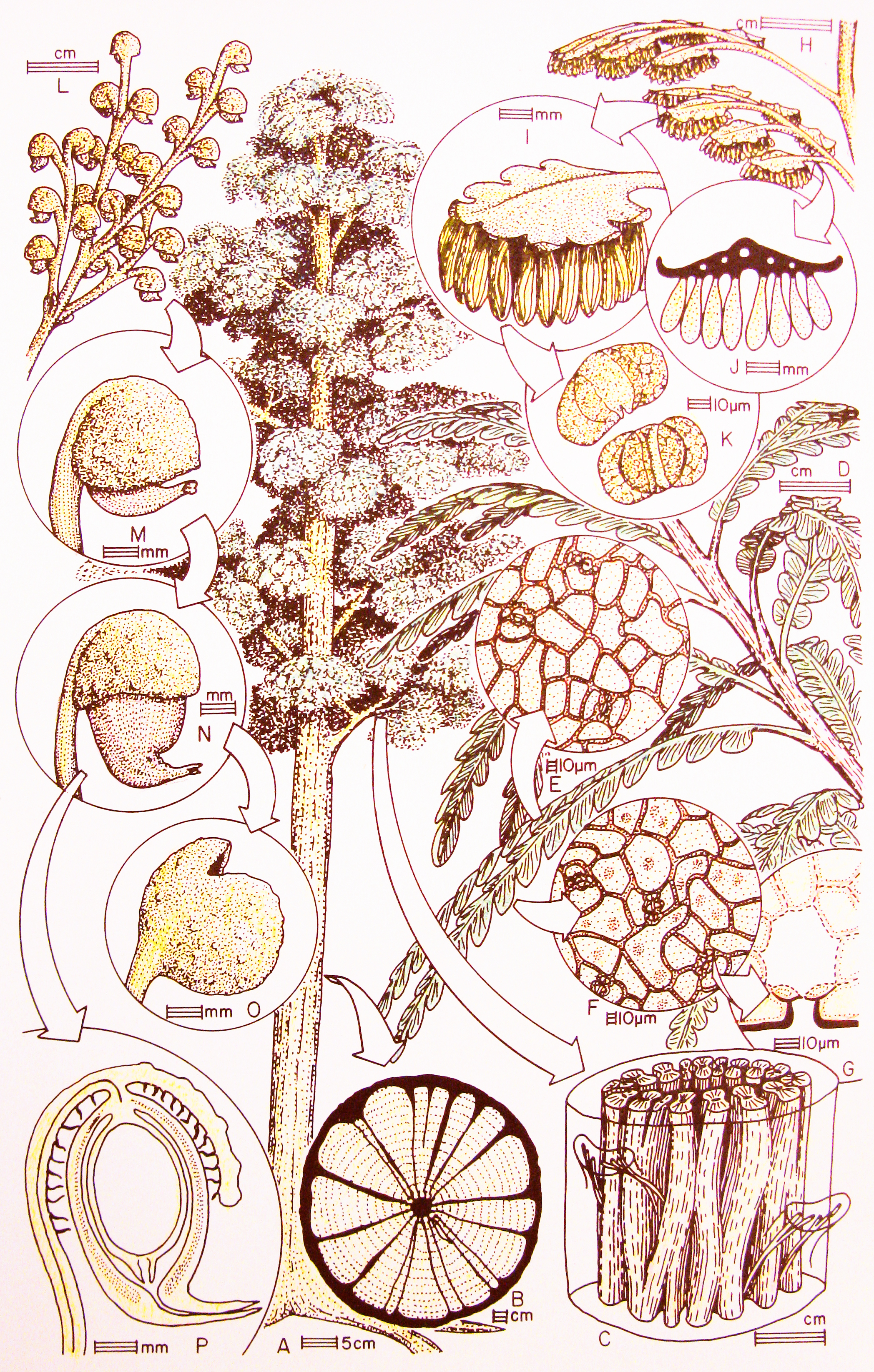Umkomasia Macleani Reconstruction on:
[Wikipedia]
[Google]
[Amazon]
''Umkomasia'' is a 
genus
Genus ( plural genera ) is a taxonomic rank used in the biological classification of extant taxon, living and fossil organisms as well as Virus classification#ICTV classification, viruses. In the hierarchy of biological classification, genus com ...
of seed bearing organs produced by corystosperm seed ferns
A seed is an embryonic plant enclosed in a protective outer covering, along with a food reserve. The formation of the seed is a part of the process of reproduction in seed plants, the spermatophytes, including the gymnosperm and angiosperm pl ...
, first based on fossils collected by Hamshaw Thomas from the Burnera Waterfall locality near the Umkomaas River of South Africa.
He recognized on the basis of cuticular similarities that the same plant produced pollen organs ''Pteruchus
''Pteruchus'' is a form genus for pollen organs of the seed fern (Pteridospermatophyta family Umkomasiaceae. It was first described by Hamshaw Thomas from the Umkomaas locality of South Africa. It is associated with the seed bearing organs '' Um ...
'' and the leaves ''Dicroidium
''Dicroidium'' is an extinct genus of fork-leaved seed ferns that were widely distributed over Gondwana during the Triassic (). Their fossils are known from South Africa, the Arabian Peninsula, Australia, New Zealand, South America, Madagascar ...
''. Various other corystosperm seed bearing organs from the Jurassic and Cretaceous have been assigned to this genus, but recently have been given distinct genera, with ''Umkomasia'' being restricted to the Triassic.

Description
Umkomasia has helmet likecupule
A cupule is a small structure shaped like a cup, including:
* In archeology, rock cupules are circular man-made hollows on the surface of a large rock or a rock slab
** On a smaller artifact they are called a cupstone.
* In botany: the base of an ...
s around ovules
In seed plants, the ovule is the structure that gives rise to and contains the female reproductive cells. It consists of three parts: the ''integument'', forming its outer layer, the ''nucellus'' (or remnant of the megasporangium), and the fe ...
born in complex large branching structures.
Whole plant associations
*''Umkomasia feistmantelii
''Umkomasia feistmantelii'' is an unusually large species of ''Umkomasia'' from the Early Triassic of New South Wales, Australia.
Description
''Umkomasia feistmantelii'' is found both with cupules enclosing the large seeds and with cupules ...
'' from the Early Triassic
The Triassic ( ) is a geologic period and system which spans 50.6 million years from the end of the Permian Period 251.902 million years ago ( Mya), to the beginning of the Jurassic Period 201.36 Mya. The Triassic is the first and shortest period ...
of Australia
Australia, officially the Commonwealth of Australia, is a Sovereign state, sovereign country comprising the mainland of the Australia (continent), Australian continent, the island of Tasmania, and numerous List of islands of Australia, sma ...
may have been produced by the same plant as ''Pteruchus barrealensis
''Pteruchus barrealensis'' is an unusually large species of ''Pteruchus'' with very elongate polleniferous heads from Early Triassic of Australia and Argentina.
Description
''Pteruchus barrealensis'' is one of the geologically earliest species ...
'' (pollen organs) and ''Dicroidium zuberi
''Dicroidium zuberi'' is a large bipinnate species of the seed fern ''Dicroidium'' with a forked rachis
In biology, a rachis (from the grc, ῥάχις [], "backbone, spine") is a main axis or "shaft".
In zoology and microbiology
In verteb ...
'' (leaves)
*''Umkomasia macleanii'' from the Late Triassic
The Triassic ( ) is a geologic period and system which spans 50.6 million years from the end of the Permian Period 251.902 million years ago ( Mya), to the beginning of the Jurassic Period 201.36 Mya. The Triassic is the first and shortest period ...
of South Africa
South Africa, officially the Republic of South Africa (RSA), is the southernmost country in Africa. It is bounded to the south by of coastline that stretch along the South Atlantic and Indian Oceans; to the north by the neighbouring countri ...
may have been produced by the same plant as ''Pteruchus africanus
''Pteruchus africanus'' is a pollen organ of a seed fern (Pteridospermatophyta). It was first described by Hamshaw Thomas from the Umkomaas locality of South Africa.
Description
The pollen organs ''Pteruchus africanus'' differ from other spe ...
'' (pollen organs) and ''Dicroidium odontopteroides
''Dicroidium odontopteroides'' was a common and widespread species of ''Dicroidium'' known from South Africa, Australia, New Zealand, South America and Antarctica. The species was first discovered in Triassic sediments of Tasmania and described ...
'' (leaves)
Reassigned species
* ''U.'' ''franconica'' Lower Jurassic, Germany, reassigned to the genus '' Kirchmuellia'' * ''U. asiatica'' Triassic, China reassigned to the genus '' Stenorachis'' * ''U. mongolica'' Lower Cretaceous, Mongolia, moved to the genus '' Doylea.''See also
*Evolution of plants
The evolution of plants has resulted in a wide range of complexity, from the earliest algal mats, through multicellular marine and freshwater green algae, terrestrial bryophytes, lycopods and ferns, to the complex gymnosperms and angiosperms (fl ...
References
External links
* {{Taxonbar, from=Q25095279 Permian plants Triassic plants Prehistoric plant genera Pteridospermatophyta Permian first appearances Triassic extinctions